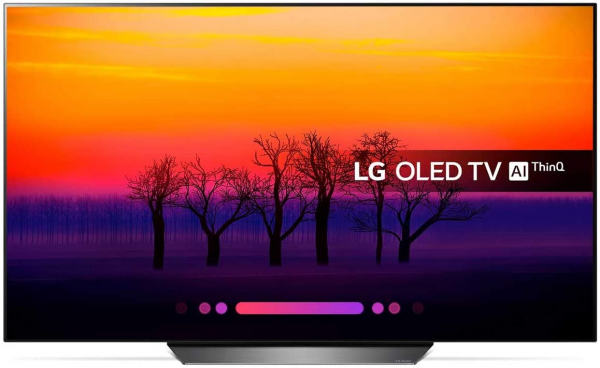LG
LG 55B8: Korean's Most Affordable 4K Oled TV in 2018
Aprox. 1279€
See specificationsThe most affordable TV in the Oled 4K range of 2018, the LG 55B8 is distinguished from the C8 by its ultimately more sober design and also by its α7 processor supposed to be less efficient than the α9 of other Oled models in the 8 series. that this Oled television set, sold for less than € 2,000 when it comes out, has in store for us.
Positive points
Image quality.
Excellent colorimetry in SDR mode and good in HDR Cinema.
HDR processing without clipping.
Infinite contrast.
Viewing angles.
Powerful α7 processor (scaling, motion compensation motor).
Responsiveness of Oled technology.
Audio system.
Slight delay in display.
Bad points
Poor color fidelity in game mode.
Non-backlit remote control.
Light peak slightly lower than on the 55C8.
Our review
Presentation
Cousin of the LG 55C8, the LG Oled 55B8 TV has the same 10-bit 55-inch (~ 140 cm) 10-bit Oled screen with an Ultra HD definition of 3,840 x 2,160 px. If the structure of the sub-pixels is different from that of the 2017 models, the characteristics of the panel remain very close: a maximum brightness around 780 cd / m², 99% coverage of the DCI-P3 color space, a contrast infinite and zero remanence time. Besides the design, the only difference with the C8 model is the image processing processor: the 55C8 has the α9 processor (Alpha 9), praised for its performance, while 55B8 is content with an α7, a little less powerful, but still a notch above the LG MP16 + processor that equipped last year's Oled 7 TVs. Like the 55C8 and unlike the 2017 models, this television also benefits from the black image insertion system which improves the sharpness of moving images, at the expense of maximum brightness, however.
The Oled 55B8 TV is LG's most affordable Oled model in 2018. It sells for around € 2,000. It is also available in a 65 inch version (~ 165 cm, reference 65B8) for around € 3,200. In comparison, the LG C8 is sold for 2,500 € in 55 "version (55C8) and 3,800 € in 65" version (65C8).
All the brightness and colorimetric measurements mentioned in this article were carried out with a SpectraCal C6-HDR probe and the CalMAN Ultimate software.
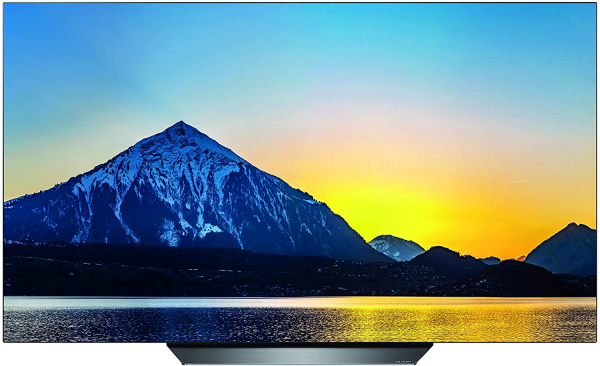
Image quality
The functioning of Oled technology at LG remains unchanged: each pixel made up of four sub-pixels (a green, a red, a blue and a white) makes it possible to reconstitute colors. The white and blue sub-pixels are larger in order to improve the maximum brightness of the screen. As always with Oled technology, the viewing angles are excellent, the loss of brightness at 45 ° is very limited and measured at 21% on this model. Obviously, there is no variation on the black which is total.
As on the 2017 models, the anti-reflective treatment is effective (since last year, LG operates a black anti-reflective filter than before, it produced purple reflections). The reflections are well diluted, even if the location of the TV in the living room remains decisive.
In Cinema mode, the color calibration is simply perfect. We measured an average delta E of only 1.2, far below the threshold of 3 below which the human eye no longer perceives any difference between the colors displayed on the screen and the expected colors. In addition, no shade exceeds a delta E of 2, which is rare enough to be emphasized.
The average gamma measured at 2.42 is very close to the reference value. There is a variation on the lighter grays, but this has very little impact on the overall rendering. Like the 2017 models, this television now has an automatic gamma mode (much simpler for the general public) which automatically switches from gamma 2.2, ideal for HD / Full HD content, to gamma 2.4 which is the standard for Ultra HD Blu-ray.
The color temperature is just perfect. There is not much more to say. Measured at 6,490 K, it is almost based on the reference value of 6,500 K, while being stable over the entire spectrum.
It is no longer a surprise, the contrast obtained by an Oled panel is considered to be infinite. Indeed, even with a white calibrated at 152 cd / m², black is measured at 0 cd / m² (our probe cannot measure a black below 0.0049 cd / m²). This contrast is still as impressive and allows you to enjoy all the nuances, even in complete darkness.
On paper, the α7 processor (Alpha 7) is less powerful than the α9 model found on other LG Oled TVs of 2018 (C8, E8, G8 and W8). However, in reality, it is very difficult to differentiate between the two models when it comes to image processing. Indeed, the α7 processor is already doing very well and in any case much better than last year's MP16 + processor. Proof that this is not just a recycling of processors from last year, but a new chip. The scaling engine is very efficient. It displays Full HD content on the Ultra HD panel while respecting the original source without creating an artifact. Like the α9, this α7 processor is compatible with 4K HFR (High Frame Rate) content at 100/120 fps only via USB / OTT. Today, no HFR mainstream content is available.
The motion compensation engine is very slightly behind that of the α9, but it is better than that offered by last year's Oled LG televisions. In addition, the black image insertion system, called TruMotion Pro, brings a real plus in terms of sharpness.

HDR
Not surprisingly, the LG 55B8 handles HDR signals in the same way as the LG 55C8. With a maximum HDR signal of 10,000 cd / m², the Display Tone Mapping perfectly follows the EOTF curve up to 60% brightness. Subsequently, the television begins to gradually smooth the curve in order to avoid clipping as much as possible. The weak point of Oled technology remains the maximum brightness, which we measured at only 663 cd / m² on the 55B8, almost 100 cd / m² less than the 55C8. In any case, this luminous peak remains much lower than that of the best high-end LCD televisions which can exceed 1,300 cd / m² (Sony 65ZD9) and even approach 1,600 cd / m² (Samsung 65Q9F).
We also measure the color accuracy in HDR mode. Cinema HDR mode provides the best color rendering. We measured the average delta E at 2.6, again a value below 3. However, the LG 55B8 does a little worse than the C8 whose delta E was less than 3 for all shades of color, which is not the case here.
Like the LG 55C8, the LG 55B8 television offers 70% coverage of Rec.2020. It is one of the best covers on the market, but it is still far from being able to reproduce all the colors promised by the Rec. 2020 standard of Ultra HD Blu-ray. Fortunately, the cinema is content for the moment with the DCI-P3 color space and the LG TV covers 95% of this space here.
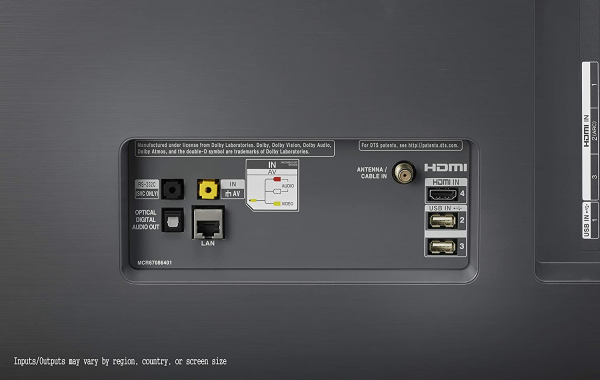
Video games
The LG Oled 55B8 television adapts very well to video games. The zero afterglow results in very little blurring behind moving objects, while the delay in displaying only 21 ms minimizes the delay between the action on the joystick and its repercussion on the screen. 'screen. LG is however not the best in the matter since Samsung has succeeded this year in reducing the input lag to 15 ms. Finally, the televisions are still a notch behind the PC monitors which can go down to 10 ms.
We assess the color fidelity in Game mode, because the atmosphere designed by the creators of the game must be respected by the TV, just like that of a film. On this point, the LG TV is not doing very well: it displays an average Delta E of 8.7, far from the threshold of 3, with a clear drift in cyan, indigo and purple tones. Fortunately, by setting the color temperature to W45, we find an average delta E of 4.4 (2.6 in HDR mode) and at temperature of 6,700 K, much more acceptable.
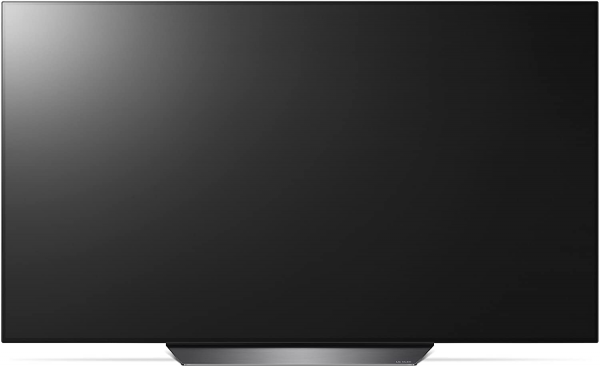
Clouding
As with all Oled TVs on the market, each pixel is managed individually and there is therefore no clouding. Banding effects (horizontal or vertical bands) are also missing from our test model, but this problem is sometimes visible on some Oled TVs. The homogeneity of the brightness on the screen is excellent, since we measured the average difference in homogeneity of the white across the entire 55 inch screen at only 5%.
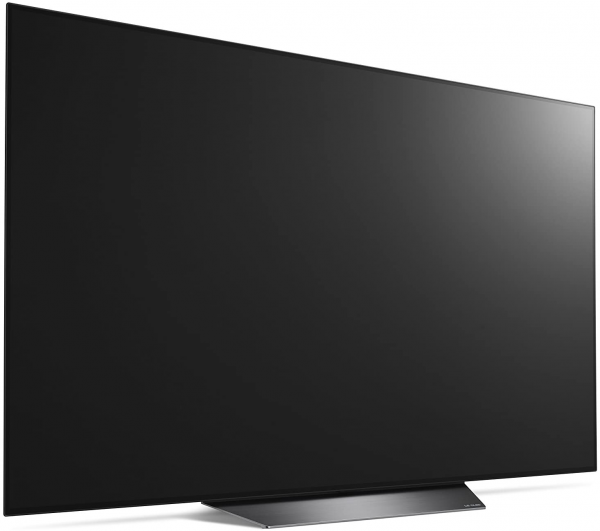
Ergonomics
LG has not been sought very far for the design of its 55B8 since it simply repeats that of the 55C7V. This design is much more sober and versatile than that of the 55C8. The design of the panel remains very refined and moreover no logo is present on the turn of the television. The mention LG Oled appears only on the foot.
The edges of the screen are very thin, especially for a 55-inch model. The Ultra HD definition on this diagonal achieves a resolution of 80 pixels per inch, sufficient to not see the pixel grid, even 50 cm from the screen.
As the Oled technology does not have a backlighting system, the thinness of the slab is extreme. On the top, the TV is only a few millimeters thick. The lower part which carries the power supply and the electronics is however a little wider, since it takes 4.7 cm. The foot, meanwhile, is only 23 cm deep. It is therefore perfectly comfortable on our 40 cm TV stand.
The back of the TV is identical to the C7V and even to this year's C8. We find the power cable on the left and the connector on the right. At the bottom center, the basic cable management system remains identical to that of the LG 55C7V. It allows all cables to go out in the same place, but without actually hiding them.
There is no change on the connection side. Like the other Oled models of the brand, the LG 55B8 offers four HDMI 2.0b inputs, three USB ports including a USB 3.0, an Ethernet port, an optical digital audio output, a headphone output, a PCMCIA port (CI + common interface) , a rake antenna connector and a satellite connector. It has a DVB-T / T2 tuner and an integrated DVB-S / S2 and DVB-C demodulator. It also has 802.11a / b / g / n Wi-Fi and Bluetooth 4.0 for connection with a wireless audio device (headphones or speaker).
The WebOS 3.5 system is still as pleasant to use, even if you start to feel a slight lack of fluidity. The main applications are available (Netflix, YouTube, Pluzz, MyTF1, Google Play Films or Deezer). They launch quickly and remain in memory for a rapid recovery. This year, LG is adding the AI ThinQ overlay which extends the number of actions available via voice control. It is then possible to carry out extensive searches (sports results, weather, etc.), to control the television ("set such channel", "record such program", etc.), to change the settings (switch to Game mode, in Cinema mode, etc.) and much more.
In terms of ignition reactivity, it is flawless. The television turns on in less than 5 seconds thanks to the "Fast recovery" option and, above all, consumes less than one watt in standby, even with this option activated. In addition, the first start-up is extremely fast (around 6 s) and the shutdown is instantaneous.
Like the 55C7V and 55C6V before it, the Oled LG 55C8V television is supplied with the Magic Remote. We find the Netflix and Amazon Prime keys as well as the Quick Access button (0 key). The very low center of gravity allows the remote control to be placed in the palm of the hand effortlessly. The gyroscope works wonderfully, as does the built-in microphone allowing voice searches. The remote control offers all the usual commands, but skips the multimedia keys, yet present on the Oled Magic Remote of the 65W7. Finally, the keys are still not backlit.
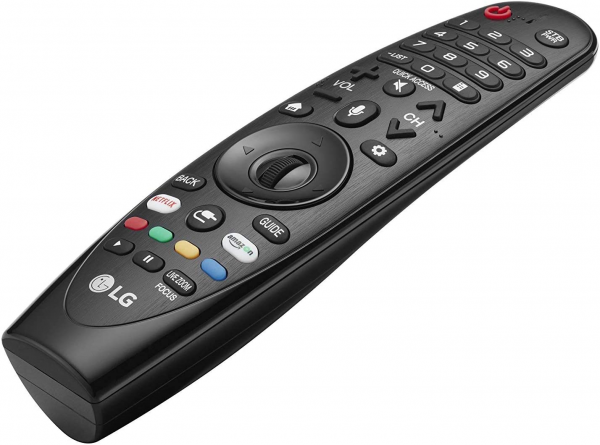
Audio
The LG 55B8 television has two speakers and two subwoofers with a total power of 60 W. The audio system has not changed since last year, but it does not need it since it delivers a quality sound for a TV. The frequency response covers a range of 60 and 20,000 Hz, corresponding to almost the entire spectrum.
Note, on 55 and 65 inch models, that the stand can be replaced by an LG SK10Y soundbar thanks to an adapter. Enough to enjoy quality sound by minimizing the space occupied on the TV stand.

Consumption
We measured the consumption of the LG 55B8 at 83 W on our test chart, a little less than the 55C8 (90 W). Relative consumption drops just below 100 W / m² (99.5 W / m²). This Oled model thus passes under this psychological bar at the price of a lower light peak. Standby consumption is always less than 1 W.
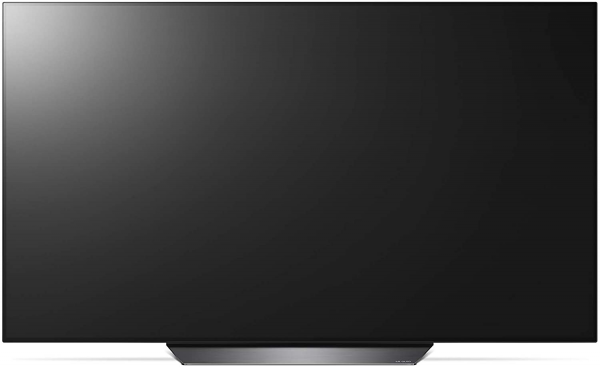
Conclusion
The LG 55B8 television delivers a high level of service, up to expectations for an Oled model. If the adoption of a less efficient α7 processor is done without too many bumps compared to the α9 model of the C8, this is not the case of the decrease in the brightness peak which is not really explained. The LG 55B8 television remains an excellent television and above all one of the cheapest Oled models on the market.
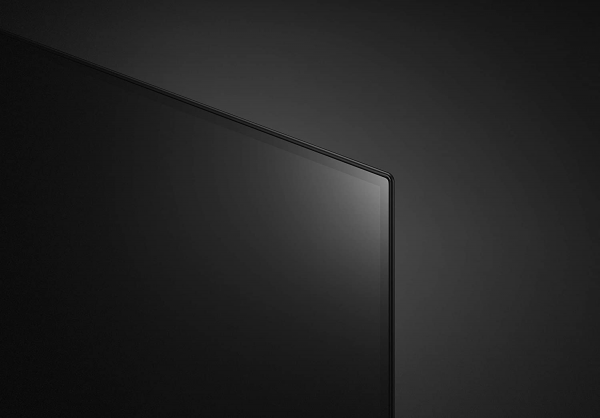
Specifications

